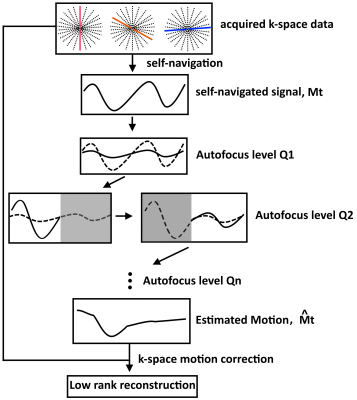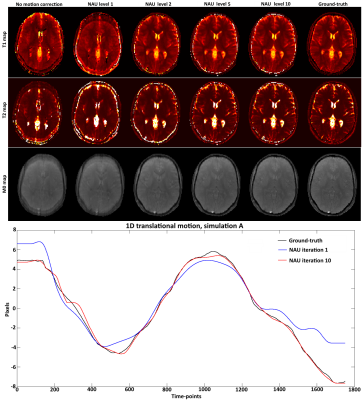4083
Zero-Dimensional Self Navigated Autofocus for Motion Corrected Magnetic Resonance Fingerprinting1School of Biomedical Engineering and Imaging Sciences, King's College London, London, United Kingdom
Synopsis
Magnetic Resonance Fingerprinting (MRF) provides simultaneous multi-parametric maps from a continuous transient state acquisition of many time-point images. Motion occurring during the MRF acquisition can create artefacts in the consequent T1/T2 maps. Here we propose to derive an intermediate 1D motion model from the acquired MRF data itself via self-navigation of the k-space central point and further refine the motion estimates using an autofocus algorithm for MRF motion correction. The proposed approach was evaluated in simulations.
Introduction
Magnetic Resonance Fingerprinting (MRF) uses a highly undersampled time-point series acquisition to simultaneously estimate T1, T2 and other quantitative parameters1. Although MRF benefits from some motion resistance1, persistent motion throughout the acquisition can create artefacts in the resulting parametric maps2,3,4. Self-contained motion correction methods are desirable in MRF, to avoid altering the magnetization state. Self-navigation methods derive motion models from k-space data itself, but may fail in dynamic contrast acquisitions such as MRF. Here we investigate a method to obtain a 1D model of the motion via zero-dimensional (central k-space point) self-navigation in MRF using Independent Component Analysis (ICA). The estimated 1D motion model, however, is only accurate up to a scaling factor and may have residual errors. Therefore an autofocus5 algorithm is employed to further improve motion estimation and correct the k-space data.Methods
Self-navigation in dynamic contrast acquisitions is challenging since variations in k-space data can result from both motion and varying magnetization states. The proposed self-Navigated AUtofocus (NAU) approach consists of three steps: 1) a zero-dimensional self-navigation step to obtain an intermediate 1D motion estimation Mt, 2) an autofocus algorithm to obtain a further refined motion estimation $$$\bf{\hat{M}_t}$$$ , and 3) a low-rank inversion6 motion corrected reconstruction. Self-navigation is achieved by normalizing the k-space centre at each time-point kt(0) by the energy $$$ \bf{E_t = \sum_r X_t(r)} $$$ of each time point image Xt(r), where Xt(r) is a motion-corrupted low-rank reconstruction of the time point series (pixel r, time-point t). Filtering and ICA are applied to the normalized self-navigated signal to obtain Mt. Although we expect Mt to capture 1D motion, it may be incorrectly scaled and may have errors resulting from static tissues and residual contrast variation. We further refine Mt iteratively in the second step of NAU using a hierarchical autofocus algorithm with a local gradient entropy metric $$$\bf{H(X) = \sum_b \{ {-\sum_r{X'(r)_b log[X'(r)_b]}}} \}$$$, where X’(r)b is the spatial gradient around block b of image X. To reduce the number of unknowns, we look for $$$ min_{\alpha , \beta} H(\hat{X}_t) $$$, where $$$\bf{\hat{X}_t}$$$ is the motion-corrected time-point series using the 1D motion model $$$\bf{\hat{M}_t} = \alpha \bf{M_t} + \beta$$$. A diagram of the NAU framework is depicted in Figure 1. The final $$$\bf{\hat{M}_t}$$$ is used to correct the acquired k-space data, followed by a final (motion corrected) low rank reconstruction.Experiments
A digital phantom modelled after a brain image with realistic T1 and T2 values was used to simulate an MRF acquisition with a sequence similar to7 under periodic 1D translational motion. Two different simulated motions (A and B) were tested. The simulated acquisition was based on: fixed TE/TR = 1.2/4.3 ms, Nt =1750 time-points, golden radial trajectory with a single spoke per time-point. The optimization for $$$\alpha$$$ and $$$\beta$$$ was performed via exhaustive search at each hierarchical level l = 1,…,10. Each hierarchical level divide the motion model in $$$Q_l$$$ = [1 2 3 5 7 11 13 17 19 23] segments in time. Thus at each level the autofocus algorithm modified $$$N_t / Q_l$$$ time-points at a time. Localized gradient entropy was measured on a block size b = 23 pixels. The low rank approximation used a rank r = 15 and Conjugate Gradient with 15 iterations.Results
T1, T2, M0 maps and estimated motion from different hierarchical levels of the proposed NAU for simulated motions A and B are shown in Figures 2 and 3, respectively. A gradual improvement of sharpness can be observed as the algorithm resolves motion at smaller temporal resolutions in later iterations. The simulated motion plots show the result of the initial global autofocus estimated motion (hierarchical level 1) as well as the last (hierarchical level 10), which is closer to the ground-truth.Conclusion
The proposed NAU method introduces a self-navigated autofocus solution for MRF motion correction. The proposed approach has the potential for motion estimation at high temporal resolution. Proof of concept was demonstrated in simulations achieving similar quality to the ground-truth T1/T2 maps. Future work will investigate feasibility in-vivo and more complex motion models8 using more efficient optimizations9.Acknowledgements
ACKNOWLEGDMENTS: This work was supported by EPSRC EP/P001009/1 and FONDECYT 1161055.References
1. Ma D et al. Nature. 2013; 495:187-192
2. Mehta et al, ISMRM 2017; abstract number 302
3. Cruz et al, ISMRM 2017; abstract number 935
4. Anderson et al, Magn Reson Med 2017; doi: 10.1002/mrm.268655
5. Atkinson et al, Magn Reson Med 1999;41:163–170.
6. Zhao et al, MRM 2017; doi:10.1002/mrm.26701
7. Jiang et al, MRM 2015; 74:1621-1631
8. Cheng et al, Magn Reson Med 2012;68:1785–1797.
9. Loktyushin et al, Magn Reson Med. 2013 doi: 10.1002/mrm.24615.
Figures


